Fish, like all animals, must obtain oxygen from the environment for respiration. Oxygen is far less available to aquatic organisms than it is to air-breathers, and the dissolved oxygen content of water may limit the activities of fish.
In most natural waters, the supply of oxygen to water (diffusion from the atmosphere and production from underwater photosynthesis) exceeds the amount used in oxygen-consuming processes, and fish seldom have problems obtaining enough oxygen to meet normal metabolic demands. In aquaculture ponds, however, the biomass of plants, animals and microbes is much greater than in natural waters, so oxygen is sometimes consumed faster than it is replenished.
Depending on how low the dissolved oxygen concentration is and how long it remains low, fish may consume less feed, grow more slowly, convert feed less efficiently, be more susceptible to infectious diseases, or suffocate and die. Aquaculturists avoid these problems by aerating ponds mechanically to supplement normal oxygen supplies.
Principles of Aeration
The rate of oxygen movement between air and water is described by the gas transfer equation:
dC/dt = KL(A/V)(Cs –Cm).
In the equation:
dC/dt =the rate of oxygen transfer between a liquid and a gas;
KL =the liquid-film coefficient;
A/V =the ratio of the air-water interfacial area to water volume;
Cs =the dissolved oxygen concentration when water is saturated with oxygen under the prevailing conditions of water temperature, salinity and atmospheric pressure; and
Cm =the measured dissolved oxygen concentration.
The liquid film coefficient, KL, incorporates a parameter called the surface renewal rate, which is related to turbulence within the liquid.
The gas transfer equation looks complicated, but it is actually simple to interpret. The equation says that the rate of oxygen transfer between air and water depends on three factors: the amount of turbulence, the ratio of surface area to water volume, and how far the prevailing dissolved oxygen concentration deviates from the dissolved oxygen concentration at saturation. This deviation is called the saturation deficit or surplus, depending on whether the measured concentration is greater than or less than the saturation concentration.
The Effect of Surface Area and Turbulence
Oxygen moves to and from water across the air-water interface. So, a greater amount of oxygen can enter or leave a given amount of water when the air-water interfacial area is increased. However, even if the water is initially low in oxygen, the thin film of water at the interface of a calm water surface quickly becomes saturated with oxygen, which dramatically slows the rate of oxygen diffusion into the water. Turbulent mixing restores the saturation deficit in the surface film by moving oxygenated water away from the surface, increasing the overall rate of oxygen transfer.
The Effect of Prevailing Dissolved Oxygen Concentration
Dissolved oxygen moves into or out of water by diffusion. The rate of diffusion depends on the difference in oxygen partial pressures between the liquid and gas phases— the greater the difference, the greater the driving force moving oxygen from one phase to the other. The maximum rate of oxygen transfer into water occurs when the dissolved oxygen concentration in water is 0 mg/L, the point at which the maximum difference in oxygen partial pressures between water and air occurs.
As dissolved oxygen concentrations increase from 0 mg/L, the oxygen partial pressure difference between air and water steadily decreases up to the point where the dissolved oxygen concentration equals the saturation concentration. At that point, there is no difference in oxygen partial pressure between water and air (this is, in fact, the definition of “saturation”). Because there is no driving force compelling oxygen molecules to leave or enter water, no oxygen can be added to water no matter how much effort is made to increase turbulence or airwater interfacial area.
When the dissolved oxygen concentration is greater than the saturation concentration (the water is supersaturated with oxygen), the oxygen partial pressure in water is greater than in air and oxygen moves from water to air. In other words, aeration causes the dissolved oxygen concentration to decrease. This process is called “degassing.”
Implications for Aeration
Each of the three factors in the gastransfer equation has important implications for pond aeration. The effects of surface area and turbulence are obvious. Aerators increase the air-water interfacial area by breaking water into fine drops or creating bubbles. Aerators also create turbulence that renews the surface film and moves oxygenated water away from the aerator. Implications of the third factor— the oxygen partial pressure difference between air and water— are a bit more complicated.
The oxygen partial pressure differential can be increased (thereby increasing the oxygen transfer rate) by increasing the saturation concentration (Cs), decreasing the measured oxygen concentration (Cm), or both. For surface aerators that splash or spray water into the air, the saturation dissolved oxygen concentration is set by prevailing atmospheric pressure, water temperature and salinity.
Under practical aquaculture conditions, the culturist cannot modify those environmental variables to increase the partial pressure differential and improve aerator performance. However, measured dissolved oxygen concentration in the pond varies diurnally, so the culturist can control aerator oxygen transfer rates by selecting when to begin aerating. This can be demonstrated by looking at a couple of extreme examples.
First, if aerators are operated on sunny afternoons when water is supersaturated, oxygen will be lost (degassed) from the water. So, unless the goal is to remove oxygen from the water or simply to mix the water, supersaturated water should not be aerated.
Second, the rate of oxygen transfer is greatest when the measured dissolved oxygen concentration is very low. In fact, oxygen- transfer rates can be maximized by waiting until dissolved oxygen concentration falls to 0 mg/L before aerating, but this has obvious drawbacks (the fish would be dead by then). On the other hand, aerating water when dissolved oxygen concentrations are near saturation is wasteful because oxygen transfer and aeration efficiency are very low under those conditions. So there are important trade-offs between biological goals (optimizing aquatic animal health by maintaining dissolved oxygen levels above some critical threshold) and physical constraints (aerator efficiency and oxygen transfer decline as dissolved oxygen concentration approaches saturation).
Although the oxygen saturation concentration cannot be manipulated to improve oxygen-transfer rates of surface aerators, this is not true for deep-water diffuser aerators (bubblers) or aerators that use pure oxygen as the gas phase. Those aerators can be very efficient because they operate under conditions where the saturation dissolved oxygen concentration is higher than in surface waters.
Aerator Performance
There are two ways of describing aerator performance. The standard oxygen transfer rate (SOTR) is the amount of oxygen added to water in 1 hour under a standard set of conditions. The units of SOTR are pounds O2/hour, which can be multiplied by 0.45 to derive the metric equivalent in kg O2/hour. Standard aeration efficiency (SAE) is the standard oxygen transfer rate divided by the power requirement in horsepower (hp). Units of SAE are pounds O2/hp?hour, which can be multiplied by 0.61 to derive SAE in metric units of kg O2/kW?hour. Boyd (1998) thoroughly describes aerator performance testing and how to interpret and use SOTR and SAE values.
Aerators transfer less oxygen under pond conditions than under the standard conditions of aerator performance tests, so SOTR and SAE values are best used to compare similar styles of aerators as an aid in selecting equipment to purchase rather than as design criteria for pond use. Also, small differences in SOTR and SAE values are not meaningful because test conditions may vary and affect results. Boyd and Ahmad (1987) compiled SOTR and SAE values for a variety of aerators used in pond aquaculture.
Good SAE values and durability are most important when selecting aerators for general day-today use. On the other hand, high SOTR values and mobility are important for aerators used to save fish in distress. Other factors such as cost, durability, specific application and ease of service must also be considered when selecting an aerator. Durability varies widely among aerators, and prospective buyers should consult the owners of various kinds of equipment for advice and recommendations.
Common Types of Aerators
Paddlewheel Aerators
Paddlewheel aerators are the most common types used in large ponds. Paddlewheels consist of a hub with paddles attached in a staggered arrangement. The aerator is powered by a tractor power take-off (PTO), self-contained diesel or gas engine, or electric motor. Electric paddlewheel aerators are usually mounted on floats and anchored to the pond bank.
There are many different designs for PTO-driven paddlewheels (Figs. 1 and 2). Gearboxes and automobile differentials have been used for gear reduction. Paddlewheel diameters (paddle tip to tip) range from 2 to 4 feet; paddles are 2 to 10 inches wide and may be rectangular, triangular or semicircular (concave) in cross section. Paddles are welded to the hub in various spiraled or staggered arrangements.
Large-diameter paddlewheels transfer more oxygen than smaller diameter aerators, and flat paddles are less effective than other designs. For a given design, oxygen transfer can be increased by increasing paddle depth and hub rotation speed. Increased diameter, paddle depth and speed also increase the power required for operation.
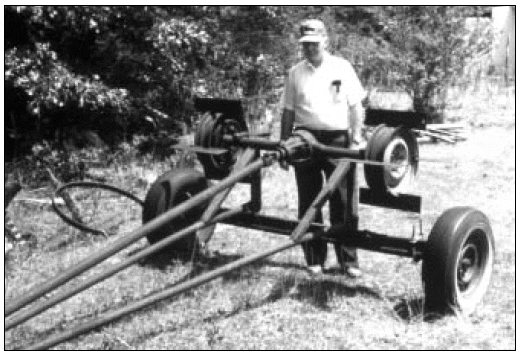
Tractor PTO-powered paddlewheels can have high SOTRs— 90 pounds O2/hour or more. Thus, they are particularly useful in emergencies. However, tractors develop more power than is applied to the PTO and aerator drive shaft, and considerable energy is lost through the drive train, so PTO-driven paddlewheels are not particularly energy efficient. But they are more flexible than other aerator designs. Because they are portable, they can be moved from pond to pond as needed and placed anywhere along the bank. The aerator also can be operated in different modes, depending upon needs.
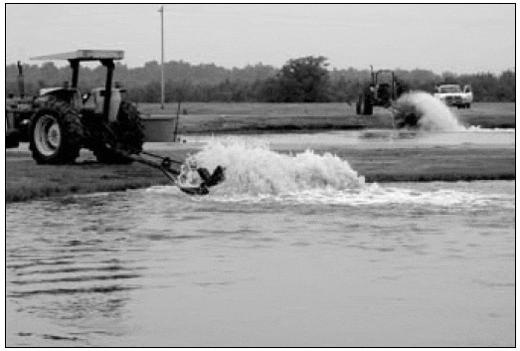
For general pond aeration, PTOdriven paddlewheels are usually operated with paddles submerged 3 to 4 inches in the water. Paddle depth can be increased to 5 to 6 inches for greater oxygen transfer, but this increases fuel consumption and produces a stronger water current, which forces fish to expend more energy (and consume more oxygen) when swimming behind the aerator. Nevertheless, the increased paddle depth may be needed when maximum oxygen transfer is important during acute dissolved oxygen depletions.
Depending on their diameter, PTO-driven paddlewheel aerators require 15 to 30 hp to operate at paddle depths of 3 to 6 inches. Tractors with PTO power ratings of 45 to 60 hp are typically used as the power source. Larger tractors may be needed to move aerators around on farms with steep, eroded pond levees, but large tractors are an inefficient power source because most of the fuel consumed is used to run the engine and power train rather than to turn the paddlewheels.
When used at paddle depths of 3 to 6 inches and driven by a tractor with a PTO power rating of 45 to 60 hp, most PTO-driven paddlewheels perform best when the tractor is operated at about half throttle (1,200 to 1,500 rpm engine speed). If the tractor has a standard 540-rpm PTO shaft and the aerator gear reduction is about 6 to 1, the PTO shaft speed will be about 500 rpm and the paddlewheel speed 80 to 90 rpm.

Tractor PTO-driven paddlewheels also can be operated with paddles almost fully submerged to mix ponds or provide a current of oxygenated water to fish held at high densities in harvest socks. When used in this manner, the tractor is operated just above idle speed (300 to 400 rpm engine speed) so that the paddlewheel speed is 20 to 30 rpm.
Some PTO-driven paddlewheels, called sidewinders (Figs. 3 and 4), use an in-line pinion-and-bullgear system to reduce PTO shaft rotation speed. Benefits of sidewinders are that they are durable and produce a current of oxygenated water parallel to the pond bank where stressed fish congregate. Sidewinders also are commonly used to produce a current of oxygenated water to sustain fish concentrated in harvest socks.
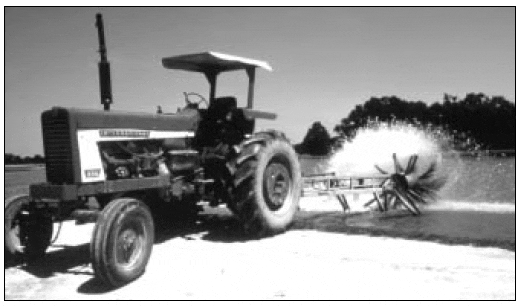
Personnel who operate PTO-driven aerators should be trained in placing and using them properly to ensure safe operation, optimal usage in critical situations, and long life of the equipment.
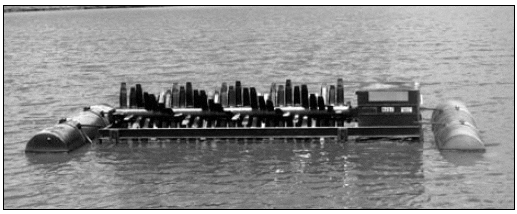
For routine, everyday use—where efficiency is important—most culturists prefer paddlewheel aerators powered by electric motors (Figs. 5 and 6). Electric paddlewheels used on commercial catfish farms are usually powered by 10- to 15-hp motors and have hubs 10 to 15 feet long. Electric paddlewheels are permanently anchored in each pond and individually controlled by switches on the pond bank. On some commercial aerators the paddle depth can be adjusted for optimum energy use and performance of the motor. The motor should draw about 90 percent of the full load amperage rating to provide maximum oxygen transfer and extend motor life.
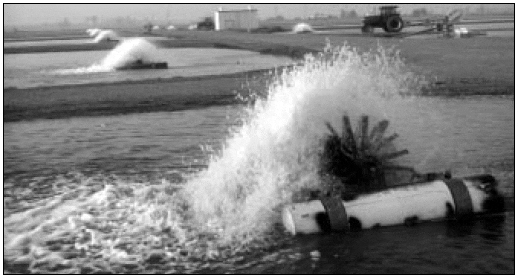
Electric paddlewheel design was systematically studied by Ahmad and Boyd (1988), who found that the best design consists of a 3-foot diameter paddlewheel with paddles that are triangular (135-degree interior angle) in cross section. Paddles are about 4 to 6 inches wide, with four paddles attached per row and spiraled in a staggered arrangement around the hub. Paddle depth is 4 to 6 inches. Paddlewheel speed should be about 90 rpm. Commercial designs similar to that proposed by Ahmad and Boyd have SAE values of 4.5 to 5.5 pounds O2/hp?hour, which is very good for surface aerators.
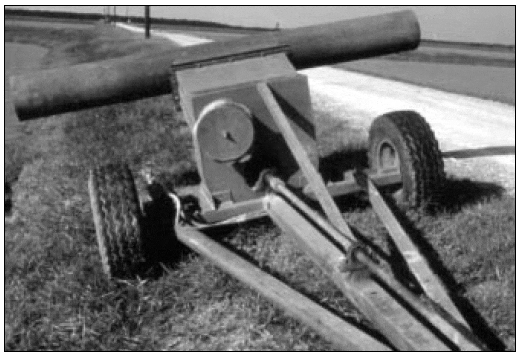
Pump-sprayer Aerators
Pump-sprayer aerators have pumps that discharge water at high velocity through pipes or manifolds. Pumps may be powered by the PTO of a tractor (Fig. 7) or by an electric motor. Pump-sprayers are simple and require little maintenance.

Pump-sprayers have a wide range of effectiveness and efficiency. Those driven by electric motors have SAE values of 1.5 to 3.5 pounds O2/hp?hour. Pump-sprayers powered by tractor PTOs have lower SAE values than electric aerators, but may have very high SOTR values (up to 160 pounds O2/hour). Aerators with higher SOTR values usually require large tractors (90 PTO hp, or more) or that the PTO be operated at a high speed (up to 1,000 rpm).
Vertical Pump Aerators
A vertical pump aerator consists of a submersible motor with an impeller attached to the output shaft. The motor and impeller are suspended beneath a float, and water is sprayed into the air through an opening in the center of the float (Fig. 8). Vertical pump aerators can be relatively efficient— SAE values usually range from 2 to 4 pounds O2/hp?hour— but most vertical pump aerators manufactured for aquaculture have relatively small motors (usually less than 1 hp) and do not produce a large area of oxygenated water. This limits their use to ponds of less than 1 acre, where they can be quite effective.
Diffusers or Bubblers
These systems use blowers or compressors to supply air to diffusers. The diffusers have many small pores that release bubbles on the pond bottom. Oxygen is transferred as the bubbles rise through the water column. Diffusers for large-scale aeration are usually discs, plates or tubes constructed of glass-bonded silica, ceramic, porous plastic, or flexible perforated membranes. Diffusers are customarily arranged in a grid pattern over the bottom of the pond, with the number of individual diffusers determined by the oxygen transfer rate of the diffuser and the oxygen consumption rate in the water. Oxygen transfer increases with smaller bubble size, deeper bubble release point, and higher oxygen content in the bubbles.
Diffused aeration is common in wastewater treatment, where basins 15 to 30 feet deep can be constructed to optimize oxygen transfer. When bubbles are released in deep water, hydrostatic pressure from the overlying water increases the saturation dissolved oxygen concentration, so that for any value of ambient dissolved oxygen, the saturation deficit is increased compared to conditions at the water surface. Deep water also creates a long contact time between bubble and water, so that more of the oxygen in the bubble is transferred to the water before the bubble reaches the surface. Aeration efficiencies are also high if very small bubbles are produced because they have a higher ratio of total surface area to water volume than large bubbles. Fine-bubble diffusers operated in deep water can have very high SAE values— some over 15 pounds O2/hp?hour.
Despite the potential for high SAE values, diffusers are seldom used in aquaculture ponds. In shallow ponds, diffusers are relatively inefficient because bubbles ascend to the surface too quickly for effective oxygen transfer. At diffuser depths of about 3 to 4 feet, SAE values of most diffusers are about 1 to 3 pounds O2/hp?hour.
Fine-pore diffusers operated at low airflow rates are more efficient, but these systems foul (clog) easily and must be cleaned often to keep them working properly. In addition to these problems, most culturists dislike diffused aeration systems because the network of supply lines and diffusers interferes with fish harvest.
Diffusers that use pure oxygen in the gas phase can have high oxygen- transfer rates, but operating costs are too high for routine aeration of large ponds. Pure-oxygen systems may, however, have important specialty uses in ponds, such as providing oxygen to fish held at high densities in live cars or socks during harvest (Torrans et al., 2003).
Aeration Practices
Basic aerator design and the types of aerators used in pond aquaculture have become somewhat standardized. Paddlewheel aerators of relatively similar design are used in most large ponds (>1 acre), and vertical pump aerators are commonly used in small ponds.
Although the choice and design of aerators have become somewhat standardized, the ways aerators are used vary widely, probably because there has been little systematic economic evaluation of aeration practices in large commercial ponds. Although many aeration experiments have been conducted in small ponds, it is difficult to relate the results of those experiments to conditions in large ponds because oxygen dynamics, mixing characteristics, fish behavior, and other factors vary so much with pond size. Because there have been few appropriate aeration trials, farmers base their aeration practices on the availability of labor and capital, their individual production goals, and the perceived effectiveness of various practices.
The variety of aeration practices used in pond aquaculture is represented at one extreme by the continuous use of intensive aeration (up to 10 hp/acre) in marine shrimp ponds and, at the other extreme, by infrequent, “emergency aeration” with 0.5 to 1 hp/acre in some fish culture ponds. In marine shrimp ponds, aerators are also used for constant water circulation, which in many respects is as important as the oxygenation process in the culture of this bottom-dwelling animal. Aeration practices used on most commercial catfish farms lie between these two extremes.
The Evolution of Aeration on Catfish Farms
Before about 1980, catfish stocking and feeding rates were low and there were few problems with dissolved oxygen, except during unusual events such as sudden phytoplankton die-offs or prolonged periods of cloudy weather during the summer. As farmers sought to increase production by stocking fish at greater densities and increasing the feeding rates, episodes of critically low dissolved oxygen concentrations became more frequent.
In the early stages of intensified production, oxygen problems remained relatively rare and catfish farmers used existing farm equipment (such as irrigation lift pumps) or aerators fabricated in farm machine shops. These early aerators used a readily available power source—a tractor PTO. Tractor-powered aerators could be moved around the farm to any pond that required supplemental aeration. Quite often, the first sign of a problem would be fish struggling to obtain oxygen at the pond surface. Farmers would then quickly place an aerator in the pond and fish would congregate in the small area of oxygenated water near the aerator.
As farmers continued to increase their catfish stocking and feeding rates in an effort to grow more fish, most ponds needed aeration on summer nights. Tractors proved too expensive and difficult to maintain for everyday use. Also, tractor-powered paddlewheels are not particularly efficient because only a portion of the energy from the tractor engine is transferred to the aerator. Floating paddlewheel aerators powered by electric motors were more efficient, and by the mid-1980s they had become the most common type used on catfish farms.
How much to Aerate
In commercial catfish ponds, aeration is commonly about 1.5 to 2 hp/acre in each pond. For example, two 10-hp electric paddlewheel aerators may be used in a 10- to 15- acre pond. There is, however, a strong trend in the catfish industry to increase aeration intensity to 2 to 3 hp/acre (three 10-hp aerators in a 10- to 15-acre pond). Many farmers also maintain a few tractor-powered aerators (one for every four or five ponds is common) for emergency situations where high oxygen transfer rates and aerator mobility are more important than aeration efficiency.
Mechanical aeration at 1.5 to 2 hp/acre meets only a fraction of the total oxygen demand of all organisms in the pond. In a typical 15-acre catfish pond, the total oxygen consumed in respiration by fish, plankton and sediment during the summer may range from 100 to more than 200 pounds of oxygen per hour. Most of the oxygen demand is accounted for by plankton and sediment respiration rather than by fish. When operated in water with a dissolved oxygen concentration of about 2 mg/L, good paddlewheel aerators transfer about 1.5 to 2.5 pounds O2/hp?hour under field conditions. Thus, an energy input of 40 to 130 hp (about 2.5 to 8.5 hp/acre) would be required to meet the total respiratory demands of fish, plankton and sediment and maintain dissolved oxygen concentrations of 2 mg/L.
Clearly, mechanical aeration at 1 to 2 hp/acre will not improve the dissolved oxygen concentration in the entire pond, but is used only to provide a small refuge of aerated water near the aerator. When dissolved oxygen concentrations are low, fish congregate in that area and remain there until oxygen conditions improve throughout the pond.
The practice of aerating only a portion of the pond and only when concentrations fall to critically low levels has the disadvantage of routinely exposing fish to suboptimal concentrations of dissolved oxygen. Despite this drawback, this is the most common aeration practice in commercial catfish ponds and is the only practice that has proved to be economically rational. Maintaining dissolved oxygen concentration above a critical threshold throughout the pond has not been shown to be economically justifiable using currently available aeration technology.
When to Aerate
The need to aerate varies seasonally because water temperature affects the rates of respiration and photosynthesis. Problems with low dissolved oxygen concentrations are rare when water temperature is consistently below 60 °F (15 °C). Problems are common when water temperature is above 80 °F (27 °C). Based on average water temperatures, aeration in northwest Mississippi catfish ponds is uncommon from mid- November through February and frequent from mid-May through mid-September. Local climates and unseasonable temperatures will, however, alter the need to aerate ponds.
Episodes of low dissolved oxygen concentration usually occur at night during the summer. Most catfish farmers manage each pond individually by measuring the dissolved oxygen concentration at intervals throughout the night and aerating when it falls below a level considered critical by the individual farmer (usually 3 to 5 mg/L). Oxygen is measured manually (see SRAC publication 4601) or, far less commonly, with continuous monitoring systems in each pond. Aeration continues until past dawn when measurements of dissolved oxygen indicate that phytoplankton photosynthesis is producing oxygen.
Commercial catfish ponds aerated on this “as-needed” basis require 500 to 1,000 hours of supplemental aeration cumulatively during the summer growing season. This corresponds to an average of about 3 to 6 hours per day per pond. Note, however, that the duration of aeration varies greatly among ponds on a given day. Some ponds may need no aeration, while others require continuous aeration throughout the day. The length of time aeration is used also depends on weather conditions. For example, during periods of warm, cloudy weather most ponds may need continuous aeration for several days.
Some catfish farmers begin aerating all ponds on the farm at some set time early each night rather than basing aeration on dissolved oxygen levels. This practice reduces the labor required for frequent monitoring, but increases energy costs by starting aeration in some ponds well before it is needed.
Aerator Placement
Little research has been conducted on this aspect of pond aeration. If water mixing is important, aerators should be placed where they will enhance pond circulation patterns. For example, water circulation in large, rectangular ponds is optimized by placing paddlewheel aerators off the bank near the middle of the long axis of the pond to direct currents across the short axis (Boyd and Watten 1989). This produces two or more (depending on how many aerators are used) water circulation cells in the pond. The worst placement is in a corner, with currents directed diagonally across the pond. When several aerators are placed in a pond, they can be located where the current of each aerator enhances the flow produced by the others aerators. For example, an aerator can be placed in each corner of the pond to direct currents parallel to the banks in the same clockwise or counterclockwise direction. One drawback to this arrangement is that aerator currents tend to erode the pond bottom around the pond margins and deposit the eroded material in the middle of the pond. The resulting central mound of loose sediment can make it difficult to harvest the aquaculture crop by seining. Also, running electrical cables to the corners of every pond on a large farm will be expensive.
Water mixing is not the primary goal of using aerators in catfish ponds, so optimizing water circulation patterns is not the most important consideration in aerator placement. Catfish become conditioned to moving near the aerator when dissolved oxygen concentrations are low, and permanently installed electric aerators should be located mainly for the convenience of the farmer. Aerators should be placed near a graveled, all-weather road for easy access during operation and maintenance. They also should be near the main power source to reduce the length of power lines.
If more than one permanent aerator is to be installed in each pond, many farmers prefer to install them near each other (all in one end of the pond, for example) rather than to space them widely along the pond bank. If several aerators are located far apart and one of them fails at a critical time, fish will be forced to swim a long distance through oxygendeficient waters to find a haven near the remaining aerators. Putting all the aerators in one end of the pond also reduces the cost of the electrical supply and makes routine maintenance easier.
Portable aerators, such as tractor PTO-driven paddlewheels, should either be placed in the same location each time they are used so that fish become accustomed to the location or placed where oxygen- stressed fish have congregated. For example, when the dissolved oxygen concentration varies from one end of the pond to the other, most fish will be in the end where the concentration is highest and the aerator should be placed at that end. If a portable aerator is used to supplement an existing aerator or to replace a malfunctioning permanent aerator, it should be placed near the other aerator so that fish are not forced to swim a long distance to find the new aerator.


